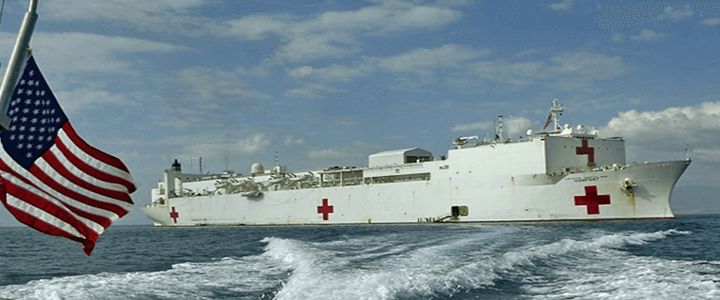President Trump visited Puerto Rico Tuesday, but from a public relations standpoint, it did not go well. That’s too bad. Despite what the mayor of San Juan wants people to believe, the federal government is getting aid to the island, and it’s starting to get out of the ports. The president’s off-the-cuff comments distract from the real work that is being done.
According to FEMA, at least 3,500 federal workers were on the ground in Puerto Rico and the U.S. Virgin Islands on Sept. 21, the day after Hurricane Maria made landfall on Puerto Rico. The next day, that number doubled to 7,000. As of Wednesday morning, after the arrival of the Comfort, there were more than 13,000 federal personnel on the ground. All the airports are open, as are all the ports.
There’s still a long, long way to go, but the criticism coming from certain quarters is simply unjustified.
“ready to relieve human suffering”
In the list of military assets dedicated to the Defense Support to Civil Authorities mission in Puerto Rico, few are more significant, or harder to miss, than the USNS Comfort, the 1,000-bed hospital ship that arrived in San Juan Tuesday. The ship, under the command of the Military Sealift Command, is manned by a crew of 800, “including Navy medical and support staff assembled from 22 commands, as well as over 70 civil service mariners,” according to the Navy Public Affairs Support Element East.
The Comfort is a floating hospital, billed as “one of the largest trauma facilities in the United States.” She will take the pressure off civilian hospitals on the island. According to a FEMA infographic released Wednesday morning, 92 percent of Puerto Rico’s hospitals are open, but as of Monday morning’s press briefing, only 10 had electricity. The rest were running on generator power.
The Comfort got right to work, hosting a medical summit with civilian medical personnel and relief coordinators. The commanding officer, Capt. Kevin Buckley, told the group, including the U.S. surgeon general and Puerto Rico’s secretary of health, “My staff is ready to go, my staff is ready to relieve human suffering.”
CURARE AEGRA PERMARINUM
The Comfort, based out of Norfolk, Va., and her sister ship the USNS Mercy, based out of San Diego, began their lives as oil tankers. In the mid-1980s, they were converted to hospital ships. The Comfort is built to handle combat casualties, making her even more capable than many land-based hospitals. At 894 feet long (almost three football fields) and 106 feet wide, she hold 12 operating rooms, an 80-bed intensive care unit, four x-ray machines, a CT scanner, and four water purification units that can produce a total of 300,000 gallons of drinking water a day.
Since entering service in 1987, she has served in Operations Desert Shield and Desert Storm, in support of Haitian operations in 1994, deployed to New York City following the 9/11 attacks, and spend 56 days in the Persian Gulf during the 2003 invasion of Iraq. This is not her first hurricane humanitarian support operation; she deployed to Pascagoula, Miss. and New Orleans after Hurricanes Katrina and Rita in 2005.
Her motto, “Curare Aegra Permarinum,” aptly means “Care of the Sick on the Sea.” Make that sea and land for now.




